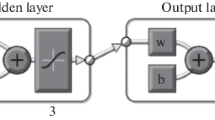Abstract
While welding processes are of great importance in manufacturing, their modeling and control is still subject of research. The highly nonlinear, strongly coupled, and multivariable nature of these processes renders the use of analytical tools practically impossible. In this article a novel approach is presented which employs networks of simple nonlinear units: a neural network. A widely used welding process, the Gas Tungsten Arc Welding is presented and the problem of its modeling and control is exhibited. A very brief introduction to neural networks is followed by presenting the experimental results for modeling the static and dynamic behavior of the process, as well as some practical recommendations regarding the use of the neural network techniques for controlling these processes.
Similar content being viewed by others
References
Andersen, K., Barnett, R. J., Cook, G. E., Ramaswamy, K. and Prasad, T. (1988) Intelligent gas tungsten arc welding control — phase I final report, National Aeronautics and Space Administration, Contract No. NAS8-37306.
Andersen, K., Barnett, R. J., Springfield, J. F. and Cook, G. E. (1991) Intelligent gas tungsten arc welding control —phase II final report, National Aeronautics and Space Administration, Contract No. NAS8-37401.
Connor, L. P. (1987)Welding Handbook, Volume 1: Welding Technology, American Welding Society. Miami, Florida.
Cook, G. E. (1980) Feedback control of process variables in arc welding, inProceedings of the Joint Automated Control Conference, Vol. II, IEEE Publ. 80CH1580-0. New York, The Institute of Electrical and Electronic Engineers, Inc., pp. FA7—B—1—10.
Cook, G. E. (1981) Feedback and adaptive control in automated arc welding systems.Metal Construction,13(9), 551–556.
IEEE (1988) Special issue on neural networks in control.IEEE Control Systems Magazine,8.
Jordan, M. L. (1988) Supervised learning and systems with excess degrees of freedom, inProceedings of the 1988 Connectionist Models Summer School, Morgan Kaufmann Publishers, CA, pp. 62–75.
Hopfield, J. J. (1982) Neural networks and physical systems with emergent collective computational abilities.Proceedings of the National Academy of Sciences, USA,79, 2554–2558.
Kolmogorov, A. N. (1957) On the representation of continuous functions of many variables by superposition of continuous functions of one variable and addition.Doklady Akademii Nauk SSSR,114, 953–956.
Lancaster, J. F. (ed.) (1986)The Physics of Welding, International Institute of Welding, Pergamon Press, 2nd Edition.
Lapedes, A. and Farber, R. (1988) How neural nets work, inNeural Information Processing Systems. American Institute of Physics, New York, pp. 442–456.
Lippmann, R. P. (1987) An introduction to computing with neural nets,IEEE ASSP Magazine, pp. 4–22.
Lippmann, R. P., Gold, B. and Malpass, M. L. (1988) A comparison of Hamming and Hopfield neural nets for pattern classification, MIT Lincoln Laboratory Technical Report, TR769.
McCullogh, C. A. and Pitts, W. (1943) A logical calculus of the ideas imminent in nervous activity.Bulletin of Mathematical Biophysics,5, 115–133.
Pearlmutter, B. (1988) Learning state space trajectories in recurrent neural networks, inProceedings of the 1988 Connectionist Models Summer School, Morgan Kaufmann Publishers, CA, pp. 113–117.
Pineda, F. J. (1988) Generalization of backpropagation to recurrent and higher-order neural networks, inNeural Information Processing Systems, American Institute of Physics, New York, pp. 602–611.
Robinson, A. J. and Fallside, F. (1988) Static and dynamic error propagation networks with application to speech coding, inNeural Information Processing Systems. American Institute of Physics, New York, pp. 632–641.
Rumelhart, D. E., Hinton, G. E. and Williams, R. J. (1986)Parallel Distributed Processing,12, MIT Press, Cambridge, MA.
Widrow, B. and Hoff, M. E. (1960) Adaptive switching circuits,1960 IRE WESCON Conv. Record, Part 4, pp. 96–104.
Author information
Authors and Affiliations
Rights and permissions
About this article
Cite this article
Karsai, G., Andersen, K., Cook, G.E. et al. Neural network methods for the modeling and control of welding processes. J Intell Manuf 3, 229–235 (1992). https://doi.org/10.1007/BF01473900
Received:
Accepted:
Issue Date:
DOI: https://doi.org/10.1007/BF01473900




